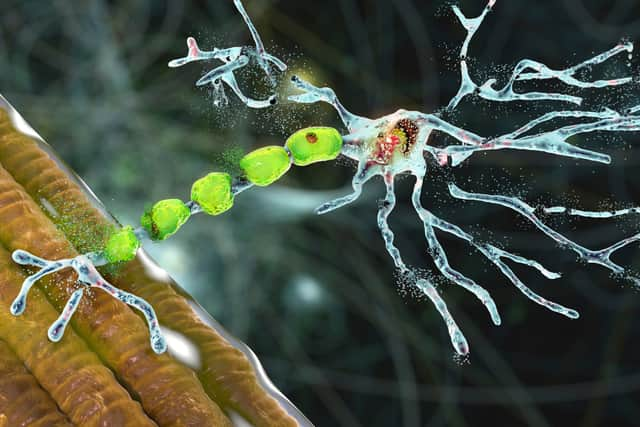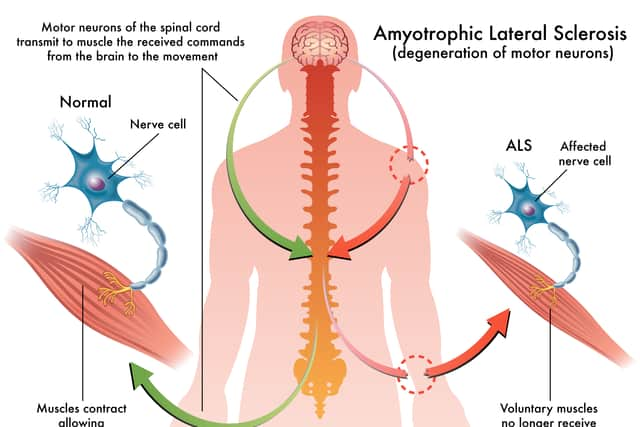Motor neurone disease: MND symptoms, early signs to look out for, treatments and breakthrough drug - explained
and live on Freeview channel 276
A genetically targeted treatment for motor neurone disease (MND) developed by US company Biogen has found that there are benefits of its new drug tofersen. The drug targets a defective gene called SOD1, which causes about 2% of cases of MND, also known as amyotrophic lateral sclerosis and ALS in the US.
Pamela Shaw, professor of neurology at Sheffield university and leader of the UK arm of Biogen’s clinical study said: “I have conducted more than 25 MND clinical trials and the tofersen trial is the first in which patients have reported an improvement in their motor function.” The benefits to patients’ motor and lung functions only became clear when the study was extended to a year, as it had initially failed. The 12-month results were published on Wednesday (21 September) in the New England Journal of Medicine.
Here’s everything you need to know about MND itself.
What is motor neurone disease?
Advertisement
Hide AdAdvertisement
Hide AdAccording to the Motor Neurone Disease Association, MND affects the nerves also known as motor neurones. These particular nerves found in your brain and spinal cord, allow it to communicate with your muscles. This means you could have issues with your mobility and movement, and you may get a wide variety of symptoms.
It is also known by different names across the world as there are four main types of the condition. Each type is not a separate disease, but a different form that can change the way it affects you. The problem is that there are overlapping symptoms so it can be difficult to diagnose. It generally becomes clearer over time, which means your diagnosis may have to be reviewed and changed along the way.
Amyotrophic lateral sclerosis (ALS):
ALS is the most common form of MND, with weakness and wasting in the limbs, muscle stiffness and cramps.
Bulbar onset MND or Progressive bulbar palsy (PBP):
PBP affects a small percentage of people than those diagnosed with ALS, and mainly targets the muscles of the face, throat and tongue.
Progressive muscular atrophy (PMA):
Advertisement
Hide AdAdvertisement
Hide AdPMA is even less common and affects a small proportion of people.
Primary lateral sclerosis (PLS):
PLS is considered the rarest form of MND, causing mainly weakness and stiffness that usually begins in the lower limbs, although many people experience additional problems with their speech and various other symptoms.
What are the early warning signs of motor neurone disease?
The condition affects everyone differently as a result of the variations. Not everyone has all the symptoms, and the speed of the symptoms can vary considerably. The NHS website states that you should see your GP for early symptoms such as muscle weakness, even though it may not be the case. In addition, the Motor Neurone Disease Association has said that around 35% of people experience mild cognitive change causing difficulties with planning, decision-making and language.


Early symptoms can include:
- weakness in your ankle or leg – you might trip, or find it harder to climb stairs.
- slurred speech, which may develop into difficulty swallowing some foods.
- a weak grip – you might drop things, or find it hard to open jars or do up buttons.
- muscle cramps and twitches.
- weight loss – your arms or leg muscles may have become thinner over time.
- difficulty stopping yourself from crying or laughing in inappropriate situations.
As there are also variations between the different types of the disease, here is a breakdown:
Amyotrophic lateral sclerosis (ALS):
Advertisement
Hide AdAdvertisement
Hide AdWith ALS, some people may notice they are tripping when walking or dropping things.
Bulbar onset MND or Progressive bulbar palsy (PBP):
Early symptoms may include slurring of speech or difficulty swallowing.
Progressive muscular atrophy (PMA):
Early symptoms may show as weakness or clumsiness of the hands.
Primary lateral sclerosis (PLS):
Early symptoms of PLS are very similar to other forms of MND, hence symptoms may show all of the above including weakness and stiffness, as well as additional problems.


Advertisement
Hide AdAdvertisement
Hide AdThere are, however, areas that are not affected which include the senses, so most people can still hear, taste, smell and feel with some exceptions. Bladder and bowels are reportedly not affected, but it may be harder to use the toilet due to mobility issues. Sexual function in general also not affected.
What are the main causes of motor neurone disease?
Unfortunately, MND is an uncommon condition that mainly affects people aged 50 and above, but it can affect adults of all ages. The cells in your brain and nerves, which are called motor neurones, gradually stop working over time. It is not known why this happens. It is not hereditary in most cases.
The condition affects up to 5,000 adults in the UK at a time, hence there is a one in 300 risk of getting MND across a lifetime. It can also affect people from all communities.
What is the life expectancy of a person with motor neurone disease?
MND can be life-shortening and there is no cure. Although the disease will progress, symptoms can be managed to help achieve the best possible quality of life. A few people live for many years or even decades with the condition.
Advertisement
Hide AdAdvertisement
Hide AdMoving around, swallowing and breathing get increasingly difficult, and treatments like a feeding tube or breathing air through a face mask may be needed. The Motor Neurone Disease Association has listed the potential life expectancies of the different types:
Amyotrophic lateral sclerosis (ALS):
Life expectancy is usually two to five years from the onset of symptoms.
Bulbar onset MND or Progressive bulbar palsy (PBP):
Life expectancy is between six months and three years from onset of symptoms.
Progressive muscular atrophy (PMA):
Life expectancy is usually more than five years.
Primary lateral sclerosis (PLS):
PLS is usually not life-shortening, as it progresses very slowly. It may take some time to confirm a definite diagnosis of PLS because slow progression in ALS may look similar at first.
What treatments are available for motor neurone disease?
Advertisement
Hide AdAdvertisement
Hide AdThere are no specific treatments, and it is mainly based on management of symptoms.
Hence the NHS explained treatments that can be beneficial include:
- Highly specialised clinics, typically involving a specialist nurse and occupational therapy to help make everyday tasks easier.
- Physiotherapy and exercises to maintain strength and reduce stiffness.
- Advice from a speech and language therapist.
- Advice from a dietitian about diet and eating.
- A medicine called riluzole that can slightly slow down the progression of the condition.
- Medicines to relieve muscle stiffness and help with saliva problems.
- Emotional support for you and your carer.
Whilst there are no specific treatments as of yet, the new drug may give hope to some living with the disease.
Comment Guidelines
National World encourages reader discussion on our stories. User feedback, insights and back-and-forth exchanges add a rich layer of context to reporting. Please review our Community Guidelines before commenting.
